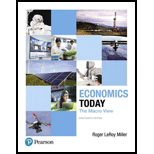
Why might people be willing to sacrifice dollars to avoid “feeling bad” about flouting tax laws?
Concept introduction:
A Tax is the mandatory financial charge or some other type of levy imposed upon a taxpayer (an individual or other legal firm by a government in order to fund various public expenditures. The government imposes a number of taxes and uses its proceedings to finance its social benefit programs and also finance its government expenditure.
Tax avoidance refers to the legal means of reducing tax liabilities on an individual. Tax avoidance is the use of legal methods to modify an individual's financial situation to lower the amount of income tax owed to the government. This is generally accomplished by claiming the permissible deductions and credits.
It is different from tax evasion as tax evasion is the failure to pay one’s tax liabilities to the government on purpose and this is considered illegal.
Want to see the full answer?
Check out a sample textbook solution
Chapter 6 Solutions
Economics Today: The Macro View (19th Edition) (Pearson Series in Economics)
- d-farrow_forwardG please!arrow_forward4. Consider two polluting firms, with the marginal abatement costs of polluters 1 and 2, respectively, equal to MAC₁ = 20-E1 MAC2 = 12-E2 a. What is the unregulated level of pollution for each firm? b. Assume policymakers have decided to cut the level of pollution in half. The way they intend to accomplish this goal is to require both firms to cut their pollution in half. What are the total costs of abatement from the policy? And how are these costs distributed between the firms? c. Is this uniform quota on emissions across firms the most cost-effective manner in which to reduce emissions by 50%?arrow_forward
- Don't used hand raiting and don't used Ai solutionarrow_forwardThanks in advance!arrow_forwardI need help figuring this out. I'm pretty sure this is correct?If Zambia is open to international trade in oranges without any restrictions, it will import 180 tons of oranges.I can't figure these two out: 1) Suppose the Zambian government wants to reduce imports to exactly 60 tons of oranges to help domestic producers. A tariff of ???? per ton will achieve this. 2) A tariff set at this level would raise ????in revenue for the Zambian government.arrow_forward
- 16:10 ← BEC 3701 - Assignments-... KWAME NKRUMAH UNIVERSITY TEACHING FOR EXCELLENCE SCHOOL OF BUSINESS STUDIES DEPARTMENT OF ECONOMICS AND FINANCE ADVANCED MICRO-ECONOMICS (BEC 3701) Assignments INSTRUCTIONS: Check instructions below: LTE 1) Let u(q1,q2) = ln q₁ + q2 be the (direct) utility function, where q₁ and q2the two goods. Denote P₁ and P2 as the prices of those two goods and let M be per period money income. Derive each of the following: a) the ordinary or Marshallian demand functions q₁ = d₂ (P₁, P₂, M) for i = 1,2 [3 Marks] b) the compensated or Hicksian demand functions q₁ = h₂ (P₁, P2, M) for i = 1,2 [3 Marks] c) the Indirect Utility Function uº = v(P₁, P2, M) [3 Marks] d) the Expenditure Function E(P1, P2, U°) [3 Marks] e) Draw a diagram of the solution. There should be two graphs, one above the other; the first containing the indifference curves and budget constraint that characterize the solution to the consumer's choice problem; the second characterizing the demand…arrow_forwardHow would you answer the question in the News Wire “Future Living Standards”? Why?arrow_forwardal Problems (v) T (ix) F 1. Out of total number of 2807 women, who were interviewed for employment in a textile factory, 912 were from textile areas and the rest from non-textile areas. Amongst the married women, who belonged to textile areas, 347 were having some work experience and 173 did not have work experience, while for non-textile areas the corresponding figures were 199 and 670 respectively. The total number of women having no experience was 1841 of whom 311 resided in textile areas. Of the total number of women, 1418 were unmarried and of these the number of women having experience in the textile and non-textile areas was 254 and 166 respectively. Tabulate the above information. [CA. (Foundation), May 2000 Exactly (14) of the total employees of a sugar mill were these were married and one-halfarrow_forward
- How did Jennifer Lopez use free enterprise to become successful ?arrow_forwardAn actuary analyzes a company’s annual personal auto claims, M and annual commercialauto claims, N . The analysis reveals that V ar(M ) = 1600, V ar(N ) = 900, and thecorrelation between M and N is ρ = 0.64. Compute V ar(M + N ).arrow_forwardDon't used hand raitingarrow_forward

 Principles of Economics (12th Edition)EconomicsISBN:9780134078779Author:Karl E. Case, Ray C. Fair, Sharon E. OsterPublisher:PEARSON
Principles of Economics (12th Edition)EconomicsISBN:9780134078779Author:Karl E. Case, Ray C. Fair, Sharon E. OsterPublisher:PEARSON Engineering Economy (17th Edition)EconomicsISBN:9780134870069Author:William G. Sullivan, Elin M. Wicks, C. Patrick KoellingPublisher:PEARSON
Engineering Economy (17th Edition)EconomicsISBN:9780134870069Author:William G. Sullivan, Elin M. Wicks, C. Patrick KoellingPublisher:PEARSON Principles of Economics (MindTap Course List)EconomicsISBN:9781305585126Author:N. Gregory MankiwPublisher:Cengage Learning
Principles of Economics (MindTap Course List)EconomicsISBN:9781305585126Author:N. Gregory MankiwPublisher:Cengage Learning Managerial Economics: A Problem Solving ApproachEconomicsISBN:9781337106665Author:Luke M. Froeb, Brian T. McCann, Michael R. Ward, Mike ShorPublisher:Cengage Learning
Managerial Economics: A Problem Solving ApproachEconomicsISBN:9781337106665Author:Luke M. Froeb, Brian T. McCann, Michael R. Ward, Mike ShorPublisher:Cengage Learning Managerial Economics & Business Strategy (Mcgraw-...EconomicsISBN:9781259290619Author:Michael Baye, Jeff PrincePublisher:McGraw-Hill Education
Managerial Economics & Business Strategy (Mcgraw-...EconomicsISBN:9781259290619Author:Michael Baye, Jeff PrincePublisher:McGraw-Hill Education





